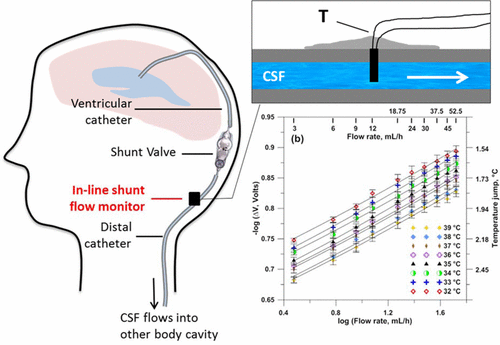当前位置:
X-MOL 学术
›
Anal. Chem.
›
论文详情
Our official English website, www.x-mol.net, welcomes your
feedback! (Note: you will need to create a separate account there.)
Inline Shunt Flow Monitor for Hydrocephalus
Analytical Chemistry ( IF 6.7 ) Pub Date : 2017-07-20 00:00:00 , DOI: 10.1021/acs.analchem.7b02034 Chuchu Qin 1 , Brian Stamos 1 , Purnendu K. Dasgupta 1
Analytical Chemistry ( IF 6.7 ) Pub Date : 2017-07-20 00:00:00 , DOI: 10.1021/acs.analchem.7b02034 Chuchu Qin 1 , Brian Stamos 1 , Purnendu K. Dasgupta 1
Affiliation

|
In hydrocephalus, cerebrospinal fluid (CSF) builds up in the cranial cavity causing swelling of the head and potentially brain damage. A shunt to drain the fluid into a body cavity is now universally used, but failure is all too common. Techniques for ascertaining shunt failure are time-consuming, expertise-dependent, and often inconclusive. We report here an inline system that reliably and quantitatively measures the CSF flow rate. The system uses a single thermistor to both heat the surrounding and to sense the temperature. In the heating mode, the thermistor is subjected to a 5 s voltage pulse. In the sensing mode, it is part of a Wheatstone’s bridge, the output being proportional to temperature. The signal, Vi – Vf, which is the net change ΔV in the bridge output immediately before and after the heat pulse, depends both on the flow rate and the surrounding temperature. In vitro, a single equation, flow rate = 3.75 × 10–6 × ΔV(−9.568+1.088 Vi) provided good prediction for the flow rate, with 6.3% RMS relative error. The sensor behavior is reported for flow rates between 0–52.5 mL/h at 32–39 °C, adequately covering the range of interest.
中文翻译:

脑积水的串联分流监护仪
在脑积水中,脑脊液(CSF)积聚在颅腔中,导致头部肿胀并可能对脑部造成损害。现在普遍使用分流器将流体排入体腔,但是故障非常普遍。确定分流器故障的技术是耗时的,取决于专业知识的,并且通常是不确定的。我们在这里报告一种可以可靠,定量地测量CSF流量的在线系统。该系统使用单个热敏电阻来加热周围环境并感应温度。在加热模式下,热敏电阻承受5 s的电压脉冲。在感应模式下,它是惠斯通电桥的一部分,输出与温度成正比。信号V i – V f,它是净变化量ΔV紧接在热脉冲前后的电桥输出中的流量取决于流量和周围温度。在体外,一个单独的方程式,流速= 3.75×10 –6 × ΔV (-9.568 + 1.088 V i)提供了很好的流速预测,RMS相对误差为6.3%。报告的传感器行为是在32–39°C下0–52.5 mL / h之间的流速下,足以涵盖所关注的范围。
更新日期:2017-07-21
中文翻译:

脑积水的串联分流监护仪
在脑积水中,脑脊液(CSF)积聚在颅腔中,导致头部肿胀并可能对脑部造成损害。现在普遍使用分流器将流体排入体腔,但是故障非常普遍。确定分流器故障的技术是耗时的,取决于专业知识的,并且通常是不确定的。我们在这里报告一种可以可靠,定量地测量CSF流量的在线系统。该系统使用单个热敏电阻来加热周围环境并感应温度。在加热模式下,热敏电阻承受5 s的电压脉冲。在感应模式下,它是惠斯通电桥的一部分,输出与温度成正比。信号V i – V f,它是净变化量ΔV紧接在热脉冲前后的电桥输出中的流量取决于流量和周围温度。在体外,一个单独的方程式,流速= 3.75×10 –6 × ΔV (-9.568 + 1.088 V i)提供了很好的流速预测,RMS相对误差为6.3%。报告的传感器行为是在32–39°C下0–52.5 mL / h之间的流速下,足以涵盖所关注的范围。













































 京公网安备 11010802027423号
京公网安备 11010802027423号